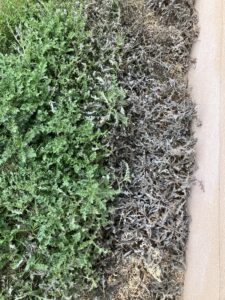Well-designed research studies show that conventional lawn care exposes dogs to herbicides like 2,4-D and glyphosate (Roundup), increasing their risk of developing bladder cancer, non-Hodgkin’s lymphoma, multicentric lymphoma, and other malignancies.
Risk factors include the frequency of herbicide applications, the chemicals involved, proximity to agricultural land that is routinely treated, and geographical location. In August 2025, the Dog Aging Project reported that its survey of 47,444 dogs across the United States gathered from January 2020 to December 2023 compared environmental exposures to health outcomes in four regional areas. Regular weed control corresponded with adverse health outcomes in dogs living in the South and Midwest more than in the West or Northeast. This finding corresponds with a 2019 NBC News map of toxic herbicide application by state.
Alternative Weed Killers That Are Safer for Pets
Rather than chemical herbicides, organic garden stores offer weed-killing products with safer ingredients such as:
- Vinegar (acetic acid, household or concentrated for horticultural use)
- Sodium chloride, sea salt, table salt, pool salt, or Epsom salts
- Citric acid or lemons
- Essential oils used in aromatherapy
- Iron sulfate
- Corn gluten meal
These ingredients disrupt cell walls, cause dehydration and nutrient imbalances, or suppress weed seed germination. Soap, fatty acids, and sodium lauryl sulfate are used as surfactants to mix ingredients and break down surface tension, helping sprays penetrate leaves.
Differences between brands depend on ingredient combinations and their concentration. For example:
- Green Gobbler Weed Killer contains 20% acetic acid (horticultural vinegar).
- Natural Elements Weed Killer contains horticultural vinegar, salt, and sodium lauryl sulfate.
- Mighty Mint Weed and Grass Killer contains sodium lauryl sulfate, spearmint essential oil, and geraniol (a geranium extract).
- Natural Armor All-Natural Weed Killer contains salt, clove essential oil, citric acid, vinegar, sodium lauryl sulfate, glycerin, and lemon juice.
- Eco Living Solutions Pet Safe Weed Killer contains acetic acid, salt, and water.
- Spruce Weed Killer contains sodium lauryl sulfate and essential oils.
- Earth’s Ally Weed and Grass Killer contains sea salt, vinegar, soap concentrate, and citric acid.
- Earth’s Final Stop Weed & Grass Killer contains cinnamon, clove, and rosemary essential oils.
- Sunday Organic Weed and Grass Killer is an herbicidal soap made from fatty acids.
- Harris Vinegars are concentrated to 30% and more for home and garden use.
- Dandelion Doom Lawn Weed Killer contains iron, which kills broad-leaf weeds without harming grass.
- Espoma Organic Weed Preventer contains 100% corn meal gluten, which prevents the growth of common weeds while adding nutrients to grass.

For years, Montana thistles have thrived in my yard. This year I tried pet-friendly herbicides, starting with Spruce, which contains surfactants and essential oils. I followed label instructions (air temperatures were above 60 degrees F, the weather was sunny, and the ground was dry) but even though I applied the weed killer hours before rain came (the product claims to be rain-proof 10 minutes after application), and even though results looked dramatic within an hour (weeds wilted and turned grey), my thistle patch quickly revived and looked vibrant.
After watching several DIY weed-killer videos, I mixed 1 cup of pool salt with 1 gallon 30% horticultural vinegar, 2 tablespoons dish washing liquid, and 3 gallons water in a battery-operated garden sprayer. On that hot, dry August day I sprayed thistles and other weeds, staying far from lawn grass. Within an hour, the sprayed plants wilted and died. A month later, they are still dead.
Easy DIY Formulas for Pet-Friendly Weed Killers
There are also dozens of do-it-yourself pet-friendly weed sprays, all of which are less expensive than commercial brands. To apply them, use a garden watering can, hand-held sprayer, or battery-operated spray tank. Double or triple ingredients to create larger quantities.
Basic Vinegar Weed Killer
- Combine 1 gallon distilled white vinegar (the concentration sold for household use) with 1 cup salt (any type) and 1 tablespoon dish soap.
- Mix in a clean sprayer and apply to weeds. Protect nearby plants from overspray that will kill them, too. Most weeds will wilt and die within 24 to 48 hours.
- Repeat for tough or resistant weeds.
Epsom Salt Blend
- Combine 1 gallon vinegar with 2 cups Epsom salts and 1/4 cup dish soap.
- Pour into a spray bottle and apply to unwanted plants. Use around patios and walkways but not near lawns.
Vinegar-Baking Soda Blend
- Combine 1 gallon vinegar with 2 tablespoons baking soda and 1 teaspoon dish soap.
- Vigorously shake to mix the ingredients, then spray thoroughly on weeds.
Borax Weed Killer
- Mix 1 cup Borax (laundry additive) with just enough water to create a sticky paste. Wear gloves while mixing.
- Use pruning shears to cut target weeds to the ground, leaving a small stump.
- Apply the paste generously to freshly cut stems. This cut-and-paste method works best on large, semi-woody weeds like thistles. Keep the paste away from plants you don’t want to damage.
Essential Oil Weed Killer
- Mix together 1 tablespoon essential oil (any combination of clove, peppermint, wintergreen, orange, citrus, and/or cinnamon) in a spray bottle with 1 tablespoon liquid soap and 1 gallon water.
- Shake well to combine ingredients and spray on weeds.
Alcohol Weed Killer
- Combine 3 cups vodka (ethanol) or rubbing (isopropyl) alcohol with 2 teaspoons dishwashing liquid.
- Spray to cover weeds.
Cornmeal Pre-Emergent Weed Killer
- Prevent weed seeds from germinating by spreading cornmeal gluten labeled for use on lawns and gardens around flower beds and paths. This will not affect existing plants but prevents new weed growth.
- Apply whenever weed sprouts appear.
Mulching
- Remove weeds.
- Apply 2 to 3 inches of wood mulch, layers of cardboard, or landscape fabric to prevent weed germination and growth.
Heat Kills Weeds
- Boiling water is recognized by the S. Environmental Protection Agency as an effective spot treatment for weed removal. Simply pour boiling water from a pan or tea kettle over weeds to cover them completely.
- Another way to provide damaging heat is with a flame thrower, which is best used immediately after rain or watering, when there is minimal danger of spreading a fire.
Safe Application of Pet-Friendly Weed Killers
Use common sense when applying weed killers, even those considered pet safe. If recommended, wear rubber gloves, clothing that protects your skin, and, in breezy weather or when using strong concentrations, a face mask.
None of the products mentioned here claim to be safe for pets to touch or lick when first applied. Dogs should be kept indoors or away from treated vegetation until it has completely dried. Most surfaces should be safe for pets to walk on or near after 12 to 24 hours unless labels instruct otherwise. None of these products make weeds taste better, so it would be unusual for most dogs to consume them, but because swallowing treated weeds is not recommended and salt or other residues can irritate canine paw pads, redirect your puppy’s attention away from recently treated areas.
Tips for Best Results with Pet-Friendly Herbicides
Before applying a pet-friendly weed killer, prepare the area by trimming tall weeds so herbicide solutions can reach exposed leaves and stems. If possible, treat weeds during midday under direct sun, when temperatures are high, and when no rain has fallen for a few days. Follow label directions, most of which recommend saturating weeds from leaf tips to roots. Thirsty weeds absorb weed killers quickly and results are obvious within an hour or two. Multiple treatments may be needed, so be ready to reapply weed killers if plants recover or new weeds sprout.
Conditions that interfere with a treatment’s effectiveness include cool temperatures, high humidity, recent rain, or rain after treatment.
Deep-rooted weeds resist most nontoxic weed killers, so hand-pulling from damp ground, such as after rain, is an effective removal method.
Keep weed killers away from plants or grass that you want to preserve. This is especially important when using products that contain salt, borax, or concentrated vinegar, which can spread from treated areas to grass or desired plants and damage them. Salt- or borax-treated areas can become sterile so that nothing grows there until the soil is replaced.
Your Pet-Friendly Weed Control Calendar
Time of year can affect the best ways to manage weeds in your yard. Here are some seasonal tips for pet-friendly weed control:
Autumn doesn’t mean that weed season is over—in fact, it’s just beginning. September and October are ideal months for targeting perennial weeds before dormancy. Use spot treatments after raking or mowing leaves. Overseed lawns with native grasses to crowd out existing weeds. Helpful autumn ingredients include vinegar, salt, citric acid, clove oil, and citrus essential oils.
Winter weeds are usually dormant, but some cold-hardy annuals may appear in mild climates. If weeds appear in paths or patio cracks, apply boiling water or vinegar spot treatments. Salt blends are useful where decorative plants won’t be growing next spring.
Spring brings life, along with sprouting weeds, to lawns and gardens. Focus on prevention and weed removal. Apply pet-safe pre-emergent products like corn meal gluten and apply vinegar, boiling water, essential oils, or citric acid to inhibit weeds.
Summer warmth supports rapid weed growth, especially perennials. Spot treat weeds with natural sprays. For patios and cement cracks, apply boiling water or salt-based sprays. Summer’s heat maximizes the effectiveness of vinegar, salt, and essential oils in pet-friendly sprays.
Not sure which weeds you have or which are annuals or perennials? See
37 Lawn and Garden Weeds or Common Garden Weed Identification for help.
Preventing Future Weeds in Pet-Friendly Ways
Simple precautions can keep weeds from coming back. To help maintain a weed-free yard:
- Don’t mow your lawn too low. Keep grass length at 2 to 3 inches to shade seeds and minimize weed growth.
- Seed and repair patchy lawn areas to prevent weeds.
- Use phosphorus-rich fertilizers to help grass roots spread, creating thicker lawns.
- Mulch garden beds to prevent spreading weeds.
- Pull weeds as soon as you notice them.
- Minimize foot traffic, vehicles driving over the area, or unnecessary digging to keep from disturbing the soil and inviting opportunistic weeds.






I dislike this online edition because I do not own a printer and cannot save editions for future needs.
Agree. The print issues were much better.
I agree. I’d like the print issues back again.
Thank you.
Totally agree with the above. Once my subscription runs out – I won’t re-subscribe.
Very sad – I’ve been a WDJ reader for decades. This digital format simply doesn’t work for my needs.
I too enjoyed the print issue. My copies went into a notebook for quick reference. But I understand that times are changing and we must do what we can to preserve natures trees, our natural resources and conserve energy. Now instead of putting these in a notebook I move them into a folder in my email storage. I can flip right to the issues I want.
Please keep up the work you do . ♥️🐾♥️
I kept all my old issues! I refer to them frequently.
I stopped reading when it went online. Not handy or convenient. Too bad! It was such a good publication when it was paper.
I too cancelled my subscription because of the online format and all of the complaints abaove.
I too am a 2-decade WDJ subscriber. I agree with Charlotte’s comment. I loved the print issues but digital works fine. I file them in a folder, no problem.
Loved this article, from one of my favorite authors. Great ideas both commercial and DIY. I willing be trying some come spring! Thanks you.
I absolutely agree with all that has been said. I much prefer the print version.
I have all the issues dating back to the very first one and used to recommend the WDJ to students, but just can’t any more.
I will not be renewing my subscription and it really breaks my heart.
I prefer the print version as well, but I know that makes me a dinosaur. I too will probably not renew when my subscription is complete. I also have notebooks filled with the printed issues that are used for reference.
I also prefer the print version. Having been a subscriber for decades, I haven’t decided whether to renew with only the digital version available – I really don’t like it.
I sure read the print version a lot more than the digital one. The digital one gets lost too easily and I never get back to it. I really wish the printed one was still available. Thanks for listening.
Whole Dog Journal has provided me excellent information over many years. I, too, am somewhat unhappy about the disappearance of the print edition. However, I’ll continue to support the newsletter. Where else can I find top quality, intelligent advice for such a small price? I’ll find a way to save the articles relevant to my situation.